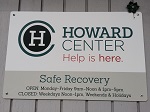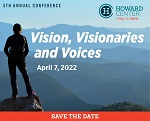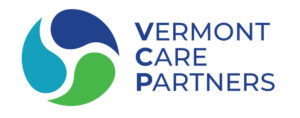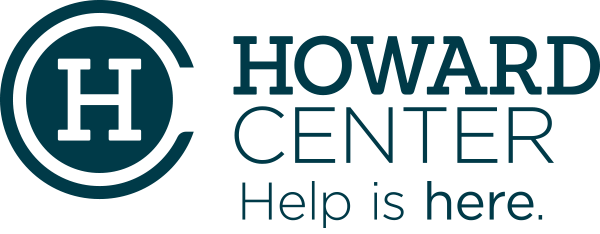Howard Center is planning mobile outreach to Vermonters who can’t get to brick-and-mortar sites.

Rendition of Clinical Van
On an early morning Zoom call in December, three Howard Center staffers gathered to finalize design details for a vehicle that will provide mobile opioid use disorder treatment beginning in the first half of 2023. Looking like a mid-size RV on the outside and a doctor’s office on the inside, the twenty-six-foot vehicle will be paid for with a combination of state and federal grant dollars and primarily serve Franklin and Grand Isle Counties.
“Since the pandemic started the frequency of overdoses has been heartbreaking. We need to reach people who can’t get to our brick-and-mortar sites,” said Grace Keller, Director of Howard Center’s Safe Recovery program
where the mobile clinic will be based. “Unfortunately, it is a process to have a clinical vehicle built so we’ll start with another van this spring with harm reduction services and to let people know the buprenorphine treatment van is coming.”
Keller explains the need for mobile outreach by pointing to Vermont Department of Health statistics showing that out of the estimated 15-20,000 Vermonters who have Opioid Use Disorder, only about 9,000 are in treatment. And those who are not in treatment are at tremendous risk. Between 2016 and 2020, nearly three-quarters of the Vermonters who lost their lives in an overdose had never been treated for Substance Use Disorder.
Making matters worse, Vermont is experiencing a huge spike in overdoses. People have become more isolated and when using opioids alone there is no one there to help if an overdose occurs. Add to that the now-common presence of the extremely powerful and often lethal opioid fentanyl, and the result is a drastic increase in overdose deaths in Vermont since 2020.
Vermont has been widely praised for building its opioid treatment capacity; eight member agencies of Vermont Care Partners, a network of Vermont’s Designated Agencies and Specialized Services Agencies, provide substance use services including prevention and education programs in schools, outpatient counseling, intensive outpatient programs, family and group counseling services, and services that support stability in the community. The Hub and Spoke system now includes nine hub treatment facilities around the state and numerous spoke providers while many other organizations provide treatment, peer support, residential care, and other services.
With so many treatment options available, it may seem puzzling that more people are not engaging in care, but a closer look shows that people aren’t accessing treatment because of issues with health, mental health, behavioral issues, transportation, or they’ve exhausted all other traditional treatment options. These barriers can mean that some don’t even attempt treatment. For others, it means they’re discharged or drop out and don’t know where else to turn for help.
 “With mobile services we’ll be able to treat people in their own communities. It’s going to mean immediate access for people who have never been able to get treatment before,” said Keller.
“With mobile services we’ll be able to treat people in their own communities. It’s going to mean immediate access for people who have never been able to get treatment before,” said Keller.
Situated in a nondescript building in downtown Burlington that was the headquarters of Champlain Drug and Alcohol Services (CDAS) until a 1994 merger created today’s Howard Center, Safe Recovery provides services based on the concept of Harm Reduction.
 “For someone with Opioid Use Disorder, recovery can be a years-long or even a lifetime process and periods of relapse are common,” explained Bob Bick, Howard Center’s CEO and the former Executive Director of CDAS.
“For someone with Opioid Use Disorder, recovery can be a years-long or even a lifetime process and periods of relapse are common,” explained Bob Bick, Howard Center’s CEO and the former Executive Director of CDAS.
“Harm Reduction means supporting people unconditionally and keeping them as safe as possible from all the ways that substances can be dangerous, no matter where they may be on their recovery continuum.”
To do this, Safe Recovery distributes the overdose reversal medication Narcan and training on how to use it. Clients have reported more than 1,700 overdose reversals using Narcan obtained from Safe Recovery since it became available in 2013. The program also provides sterile injection supplies to prevent infection, HIV and hepatitis c testing, strips to test for the presence of fentanyl, and referrals to treatment, all services that will be available in a mobile unit this spring and alongside treatment in the larger van when it’s delivered in 2023.
The addition of mobile services is the latest step in the evolution of Vermont’s treatment system for people with Opioid Use Disorder that began with the opening of the state’s first opioid treatment program in 2002 and later the statewide Hub and Spoke System in 2013. Even while the hub and spoke system was making progress toward the elimination of waiting lists in 2017, plans were taking shape for reaching the Vermonters experts knew would have difficulty being engaged or retained in the system.
In 2018, with support from the federal Substance Abuse and Mental Health Services Administration (SAMHSA), Howard Center’s Safe Recovery began to offer low-barrier access to buprenorphine, a medication for treating opioid use disorder.
 “What makes low-barrier so effective,” shares Keller, “is that instead of giving someone an appointment at a clinical location a few hours or days from now, we can start people in treatment on the day they request it, right here at Safe Recovery. The decision to start treatment can be fleeting and we want to capitalize on that moment and offer them treatment without delay.”
“What makes low-barrier so effective,” shares Keller, “is that instead of giving someone an appointment at a clinical location a few hours or days from now, we can start people in treatment on the day they request it, right here at Safe Recovery. The decision to start treatment can be fleeting and we want to capitalize on that moment and offer them treatment without delay.”
And what comes next for harm reduction services in Vermont? Bick sees growing momentum toward the creation of overdose prevention sites similar to those that have been operating in European nations and Canada for decades. Also known as safe injection sites, these are staffed by medical professionals who can intervene to prevent a fatal overdose and offer referrals to treatment programs. Officials studying the issue have concerns about the legality of such sites, particularly after an attempt to open the first in the country fell short in Philadelphia about a year ago, but with the more recent successful opening of two sites in New York, Vermont may soon follow.
“We have people who have been coming to Safe Recovery for years,” said Keller, “as frontline workers, we often know the people we are losing to overdose. We need to do more and bring services to people in a way that applies to them.”
Spring Conference
 Please join Howard Center online for Vision, Visionaries and Voices, our fifth annual spring conference on April 7, 2022. Confronting Stigma. Improving Access. Continuing Advocacy. Advancing Policy. Giving Voice. Anita Hill, Tara Westover, Bryon Katie, Ethan Nadelmann, and others will provide unique perspectives for a broad audience. Details and registration information can be found on our website at Howard Center Annual Conference 2022 – Howard Center.
Please join Howard Center online for Vision, Visionaries and Voices, our fifth annual spring conference on April 7, 2022. Confronting Stigma. Improving Access. Continuing Advocacy. Advancing Policy. Giving Voice. Anita Hill, Tara Westover, Bryon Katie, Ethan Nadelmann, and others will provide unique perspectives for a broad audience. Details and registration information can be found on our website at Howard Center Annual Conference 2022 – Howard Center.
Howard Center has a long and rich history as a trusted provider in our community. With a legacy spanning more than 150 years, Howard Center has been providing progressive, compassionate, high-quality care, support, and treatment for those members of our community in need. Founded in 1865 as an agency serving destitute children, it now offers mental health, substance use, and developmental services across the lifespan. Our staff of 1,600 provides help and support in over 60 locations throughout Vermont. More than 19,000 clients and community members turned to us last year for help to lead healthier and more fulfilling lives.
 This article is part of a series collaboratively produced by Vermont Care Partners and its members. Vermont Care Partners is a statewide network of sixteen non-profit, community-based agencies providing mental health, substance use and intellectual and developmental disability support.
This article is part of a series collaboratively produced by Vermont Care Partners and its members. Vermont Care Partners is a statewide network of sixteen non-profit, community-based agencies providing mental health, substance use and intellectual and developmental disability support.
